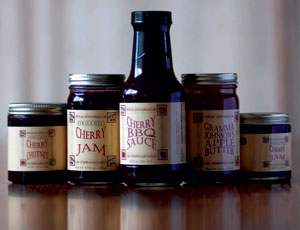YELLOW BAY – When Gary Johnson spotted a black bear in one of his family’s cherry trees, he first pointed it out to his wife Heidi and their three kids so they could see it. But when the bear wouldn’t leave, Gary had to get out the hose and chase it back into the woods. The cherries are their livelihoods, and though the Johnsons would like to live as harmoniously with the bears as possible, broken branches leaves them little choice.
Gary is the youngest of six children. When his father Ray retired from his job as an ironworker, he and his wife Carol moved the family to Montana and in 1976 bought a cherry orchard in Yellow Bay.
“This was going to be a way to early retirement,” recalls Gary, “but it didn’t quite work out like that.”
When Ray’s health failed in 2002, Gary moved back to the family orchard with his wife Heidi and their then infant son. Now, they have three kids, and are growing the family business.
 |
|
Water droplets cling to cherries growing in The Orchard at Flathead Lake in Yellow Bay. |
Their orchard, The Orchard at Flathead Lake, is one of three certified organic cherry orchards in the state.
Heidi Johnson has a background in chemical engineering and worked her way up to assistant winemaker at a Napa Valley winery. The winery was going organic by the end of her stay and the idea of organic farming started to take root.
“It’s really interesting how much sense it makes to be organic,” says Gary. He and Heidi explain organic farming as a practical method; they’re simply looking at how the cherries grow and what they really need. The Johnsons note many traditional pesticide or fertilizing regiments are generic and address bugs or mineral excesses or deficiencies that aren’t found here.
“It’s not just to take conventional stuff and do it in a different way,” Heidi says, “but to know what’s going on with your orchard and deal with it.”
The Johnsons try to attract bees to pollinate the cherry blossoms, instead of renting bees in rotation. Conventional growing makes beekeeping impossible because most pesticide applications kill indiscriminately not only the cherry fruit flies, but also the bees that pollinate and ladybugs, which eat aphids.
The biggest challenges for the organic orchard are deer eating the leaves and bears climbing trees and getting into the hives. Both may necessitate a fence, but not chemicals.
Being “certified organic” involves not only farming practice, but lots of paperwork. Heidi says they keep a list of what they’ve done, and why. This includes records of leaf sampling to show nutrient deficiencies, if any, and the products used to combat the deficit. Once a year, an inspector from the U.S. Department of Agriculture comes to check the fields and the forms.
 |
|
Gary and Heidi Johnson said picking is not expected to start until the second week of August this year, a full two weeks later than last year, due to weather conditions throughout the spring. |
Gary says people often question the point of going organic.
“Why should I grow organic? Because there’s really no other way to be growing,” he argues. “Why should I be certified? Well that’s financial.” Gary explains the USDA owns the “organic” label. In order to sell the orchard’s products as “organic,” the Johnsons need to keep careful records not only of their fruit, but the ingredients they use in their products.
The Orchard grows a variety of cherries on its 550 trees spread across 2.5 acres. In 2002, they loaded about 800 pounds of cherries into their freezer; in 2007, it was about 8,000 pounds.
“There’s a joke,” says Gary. “You know how to make a small fortune? Start with a large one.” So the Johnsons are diversifying to make The Orchard a successful business. They sell fresh organic cherries, but more as a complement to their homemade jams, barbecue sauce, and candies. Their juice is starting to appear in local brews. Flathead Lake Brewing, Tamarack Brewery and Big Sky Brewing are all clients, and the 10 Spoon Winery used their cherries for the “Sweet Mountain” dessert wine.
Now they’ve expanded their recipes and added several seasonal candies. Their products are stocked in grocery stores, health food stores and specialty shops across the state.
 |
|
Organic Cherry Chutney, Organic Cherry Jam, Cherry BBQ Sauce, Gramma Johnson’s Apple Butter are a few of the products produced by The Orchard at Flathead Lake. |
Shopping local is important to the Johnsons. They buy honey from Polson, rent out a kitchen from Mission Mountain Market in Ronan, and work with local businesses and producers as much as possible.
“We want people to support us as local farmers,” says Heidi, “so we support locally.”
Gary and Heidi hope to continue expanding the capacity and concept of The Orchard. They’d like to up their output of fruit and parlay into the agri-tourism business.
“We’d like to have people come up, see the orchard, see the kitchen, and cook them dinner,” says Gary.
For now, they’re planting more cherry trees, more varieties of fruit and keeping the bears out of the orchard.